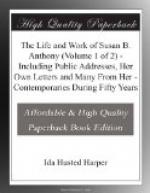On February 3 and 4, 1860, the State Woman’s Rights Convention was held at Albany in Association Hall, an interesting and successful meeting. At its close, in a letter to Mrs. Wright, Miss Anthony said: “Mr. Anson Bingham, chairman of the judiciary committee, will bring in a radical report in favor of all our claims, but previous to doing so he wishes our strongest arguments made before the committee and says Mrs. Stanton must come. I wish you would slip over there and make her feel that the salvation of the Empire State, at least of the women in it, depends upon her bending all her powers to move the hearts of our law-givers at this time. I should go there myself this very night but I must watch and encourage friends here.” Mrs. Stanton replied to her urgent appeal: “I am willing to do the appointed work at Albany. If Napoleon says cross the Alps, they are crossed. You must come here and start me on the right train of thought, as your practical knowledge of just what is wanted is everything in getting up the right document.”
The readers of history never will be able to separate Miss Anthony’s addresses from Mrs. Stanton’s; they themselves scarcely could do it. Some of the strongest ever written by either were prepared without the assistance of the other, but most of their resolutions, memorials and speeches were the joint work of both. Miss Anthony always said, “Mrs. Stanton is my sentence maker, my pen artist.” No one can excel Miss Anthony in logic of thought or vigor of expression; no one is so thoroughly supplied with facts, statistics and arguments, but she finds it difficult and distasteful to put them into written form. When, however, some one else has taken her wonderful stock of material and reduced it to shape, she is a perfect critic. Her ear is as carefully attuned to the correct balance of words as that of a skilled musician to harmony in music. She will detect instantly a weak spot in a sentence or a paragraph and never fail to suggest the exact word or phrase needed to give it poise and strength.
Mrs. Stanton had a large house and a constantly increasing family, making it exceedingly difficult to find time for literary work; so when a state paper was to be written, Miss Anthony would go to Seneca Falls. After the children were in bed, the two women would sit up far into the night arranging material and planning their work. The next day Mrs. Stanton would seek the quietest spot in the house and begin writing, while Miss Anthony would give the children their breakfast, start the older ones to school, make the dessert for dinner and trundle the babies up and down the walk, rushing in occasionally to help the writer out of a vortex. Many an article which will be read with delight by future generations was thus prepared. Mrs. Stanton describes these occasions in her charming Reminiscences:




